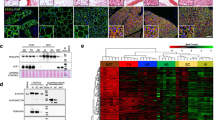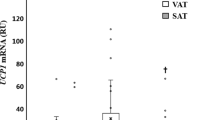Abstract
BACKGROUND:
It is known that cholinergic anti-inflammatory reflex regulates inflammation in peripheral tissues. Nicotinic acetylcholine receptors (nAChRs) are mediators of this anti-inflammatory pathway and also non-neuronal cells express functional nAChrs. A role for α7-subtype acetylcholine cholinergic receptor (α7nAChR) in insulin sensitivity improvement has already been shown in rodents both in vivo and in vitro. However, no data are available on α7nAChR expression in human adipocytes.
OBJECTIVE:
To investigate the expression and protein content of α7nAChR in human subcutaneous adipose tissue (SAT) and in isolated mature adipocytes.
DESIGN:
A total of 39 SAT biopsy specimens obtained from obese and normal-weight subjects were used to assess α7nAChR messenger RNA levels and to stimulate α7nAChR with a specific agonist and antagonist in vitro. Additional SATs from eight non-diabetic obese subjects were also studied, before and after a 3-month lifestyle intervention.
RESULTS:
α7nAChR expression was significantly lower in the SAT of obese subjects compared with that of normal-weight subjects. In mature adipocytes isolated from morbidly obese subjects (body mass index>40 kg m−2), α7nAChR expression was 75% lower compared with adipocytes from normal-weight subjects. In adipocytes of obese subjects, α7nAChR was downregulated also at protein level. In eight non-diabetic obese subjects, a lifestyle intervention (3 months of diet and physical activity) induced a significant weight loss and an increase in α7nAChR SAT expression. In vitro stimulation of adipocytes with the specific α7nAChR agonist PNU282987 induced a significant anti-inflammatory effect. Furthermore, a similar downregulation of the inflammatory profile, associated with a significant increase in α7nAChR protein level, was observed after genistein stimulation.
CONCLUSIONS:
These results provide evidence that α7nAChR expression levels are significantly decreased in obese subjects, and that this receptor modulates inflammatory gene expression in human adipocytes. The upregulation of α7nAChR by genistein stimulation opens new insights for the management of low-grade inflammation linked to human obesity.
This is a preview of subscription content, access via your institution
Access options
Subscribe to this journal
Receive 12 print issues and online access
$259.00 per year
only $21.58 per issue
Buy this article
- Purchase on Springer Link
- Instant access to full article PDF
Prices may be subject to local taxes which are calculated during checkout





Similar content being viewed by others
References
Xu H, Barnes GT, Yang Q, Tan G, Yang D, Chou CJ et al. Chronic inflammation in fat plays a crucial role in the development of obesity-related insulin resistance. J Clin Invest 2003; 112: 1821–1830.
Weisberg SP, McCann D, Desai M, Rosenbaum M, Leibel RL, Ferrante Jr AW . Obesity is associated with macrophage accumulation in adipose tissue. J Clin Invest 2003; 112: 1796–1808.
Cancello R, Clement K . Is obesity an inflammatory illness? Role of low-grade inflammation and macrophage infiltration in human white adipose tissue. Br J Obstetr Gynaecol 2006; 113: 1141–1147.
Bouloumie A, Curat CA, Sengenes C, Lolmede K, Miranville A, Busse R . Role of macrophage tissue infiltration in metabolic diseases. Curr Opin Clin Nutr Metab Care 2005; 8: 347–354.
Bourlier V, Bouloumie A . Role of macrophage tissue infiltration in obesity and insulin resistance. Diabetes Metab 2009; 35: 251–260.
Clement K, Vignes S . [Inflammation, adipokines and obesity]. Rev Med Interne 2009; 30: 824–832.
Tracey KJ . Physiology and immunology of the cholinergic antiinflammatory pathway. J Clin Invest 2007; 117: 289–296.
Bencherif M, Lippiello PM, Lucas R, Marrero MB . Alpha7 nicotinic receptors as novel therapeutic targets for inflammation-based diseases. Cell Mol Life Sci 2011; 68: 931–949.
Rosas-Ballina M, Tracey KJ . Cholinergic control of inflammation. J Intern Med 2009; 265: 663–679.
Wang H, Yu M, Ochani M, Amella CA, Tanovic M, Susarla S et al. Nicotinic acetylcholine receptor alpha7 subunit is an essential regulator of inflammation. Nature 2003; 421: 384–388.
Marrero MB, Bencherif M, Lippiello PM, Lucas R . Application of alpha7 nicotinic acetylcholine receptor agonists in inflammatory diseases: an overview. Pharm Res 2011; 28: 413–416.
Pavlov VA, Ochani M, Gallowitsch-Puerta M, Ochani K, Huston JM, Czura CJ et al. Central muscarinic cholinergic regulation of the systemic inflammatory response during endotoxemia. Proc Natl Acad Sci USA 2006; 103: 5219–5223.
Leiser SC, Bowlby MR, Comery TA, Dunlop J . A cog in cognition: how the alpha 7 nicotinic acetylcholine receptor is geared towards improving cognitive deficits. Pharmacol Ther 2009; 122: 302–311.
Marrero MB, Lucas R, Salet C, Hauser TA, Mazurov A, Lippiello PM et al. An alpha7 nicotinic acetylcholine receptor-selective agonist reduces weight gain and metabolic changes in a mouse model of diabetes. J Pharmacol Exp Ther 2010; 332: 173–180.
Wang Y, Pereira EF, Maus AD, Ostlie NS, Navaneetham D, Lei S et al. Human bronchial epithelial and endothelial cells express alpha7 nicotinic acetylcholine receptors. Mol Pharmacol 2001; 60: 1201–1209.
Wada T, Naito M, Kenmochi H, Tsuneki H, Sasaoka T . Chronic nicotine exposure enhances insulin-induced mitogenic signaling via up-regulation of alpha7 nicotinic receptors in isolated rat aortic smooth muscle cells. Endocrinology 2007; 148: 790–799.
Cho CH, Song W, Leitzell K, Teo E, Meleth AD, Quick MW et al. Rapid upregulation of alpha7 nicotinic acetylcholine receptors by tyrosine dephosphorylation. J Neurosci 2005; 25: 3712–3723.
Tracey KJ . Understanding immunity requires more than immunology. Nat Immunol 2010; 11: 561–564.
Toyabe S, Iiai T, Fukuda M, Kawamura T, Suzuki S, Uchiyama M et al. Identification of nicotinic acetylcholine receptors on lymphocytes in the periphery as well as thymus in mice. Immunology 1997; 92: 201–205.
Guarini S, Altavilla D, Cainazzo MM, Giuliani D, Bigiani A, Marini H et al. Efferent vagal fibre stimulation blunts nuclear factor-kappaB activation and protects against hypovolemic hemorrhagic shock. Circulation 2003; 107: 1189–1194.
de Jonge WJ, van der Zanden EP, The FO, Bijlsma MF, van Westerloo DJ, Bennink RJ et al. Stimulation of the vagus nerve attenuates macrophage activation by activating the Jak2-STAT3 signaling pathway. Nat Immunol 2005; 6: 844–851.
Huston JM, Ochani M, Rosas-Ballina M, Liao H, Ochani K, Pavlov VA et al. Splenectomy inactivates the cholinergic antiinflammatory pathway during lethal endotoxemia and polymicrobial sepsis. J Exp Med 2006; 203: 1623–1628.
Liu RH, Mizuta M, Matsukura S . The expression and functional role of nicotinic acetylcholine receptors in rat adipocytes. J Pharmacol Exp Ther 2004; 310: 52–58.
Wang X, Yang Z, Xue B, Shi H . Activation of the cholinergic antiinflammatory pathway ameliorates obesity-induced inflammation and insulin resistance. Endocrinology 2011; 152: 836–846.
Do Nascimento CO, Hunter L, Trayhurn P . Regulation of haptoglobin gene expression in 3T3-L1 adipocytes by cytokines, catecholamines and PPARγ. Biochem Biophys Res Commun 2004; 313: 702–708.
Acknowledgements
We thank Elena Raschi for providing LPS, and Laura Clavillo, Lidia Cova and Jenny Sassone for their helpful discussion on α7nAChR in vitro stimulation.
Author information
Authors and Affiliations
Corresponding author
Ethics declarations
Competing interests
The authors declare no conflict of interest.
Rights and permissions
About this article
Cite this article
Cancello, R., Zulian, A., Maestrini, S. et al. The nicotinic acetylcholine receptor α7 in subcutaneous mature adipocytes: downregulation in human obesity and modulation by diet-induced weight loss. Int J Obes 36, 1552–1557 (2012). https://doi.org/10.1038/ijo.2011.275
Received:
Revised:
Accepted:
Published:
Issue Date:
DOI: https://doi.org/10.1038/ijo.2011.275
Keywords
This article is cited by
-
Rise in Postprandial GLP-1 Levels After Roux-en-Y Gastric Bypass: Involvement of the Vagus Nerve–Spleen Anti-inflammatory Axis in Type 2 Diabetic Rats
Obesity Surgery (2022)
-
Invited Response on: Smoking and Physical Activity Significantly Influence Stromal Vascular Fraction Cell Yield and Viability
Aesthetic Plastic Surgery (2022)
-
Oral administration of Blautia wexlerae ameliorates obesity and type 2 diabetes via metabolic remodeling of the gut microbiota
Nature Communications (2022)
-
Cardioprotective role of GTS-21 by attenuating the TLR4/NF-κB pathway in streptozotocin-induced diabetic cardiomyopathy in rats
Naunyn-Schmiedeberg's Archives of Pharmacology (2021)
-
High-fat diet-induced obesity affects alpha 7 nicotine acetylcholine receptor expressions in mouse lung myeloid cells
Scientific Reports (2020)



